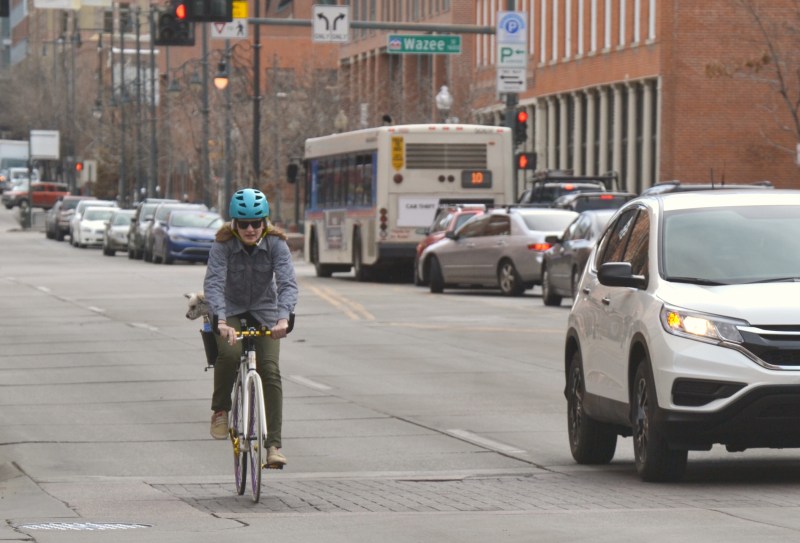3 Reasons Why Andy Kerr’s “Safety Stop” Bike Bill Makes Sense

State Senator Andy Kerr of Lakewood has introduced a bill [PDF] that would legalize two things people on bikes often do to stay safe: Carefully roll through stop signs, and travel through red traffic signals, after stopping, when there’s no cross-traffic.
To many people who don’t bike, this bill may seem like a bad idea. Why shouldn’t drivers and bicyclists follow the same traffic laws? But there are good reasons the law should acknowledge the huge differences between enclosed, multi-ton cars and light, unencumbered bicycles. Below is a breakdown of why the “safety stop” law, as Kerr calls it, makes a lot of sense.
You can sign up to speak at the Senate Transportation Committee hearing at the Capitol (Tuesday, February 7, at 1:30 p.m., room 352), or write the committee members.
1. It’s safer, according to years of data.
Idaho was the first state to adopt a similar law more than 30 years ago. Multiple studies indicate that intersections are safer because of it. One found a nearly 15 percent drop in the rate of bike injuries after legislators adopted the “Idaho stop.”

One explanation for the effect is that when bike riders can get a head start at intersections, they become more visible to the drivers behind them. That helps avoid collisions in which the driver turns across the path of a cyclist in the car’s blind spot.
Bike riders also have a better vantage point than drivers to assess proceeding through stop signs and signals because “their unenclosed and exposed position in the road allows them to see, hear, smell, and sense vibrations and assess the safety of an intersection,” according to a 2014 white paper by the Mayor’s Bicycle Advisory Committee (MBAC).
Plus people on bikes are more stable while moving forward than when stationary. “A cyclist who comes to a complete stop, has a foot on their ground, and is trying to get going again, you’ll see them wobble and swerve a little bit and they’re probably looking down at their pedals,” said Dan Grunig, executive director of Bicycle Colorado. “Whereas when they’re rolling and continuing their momentum, their eyes are up, they’re looking around, they’re paying attention to what’s going on at intersections.”
Bicycle Colorado and BikeDenver both support Kerr’s bill.
2. The “safety stop” has a long track record.
Summit County, the towns of Dillon and Breckenridge, the City of Aspen, and the entire state of Idaho have all passed a version of Kerr’s proposal. The sky did not fall.
MBAC members interviewed officials from those jurisdictions and found that the “safety stop” rule just made common sense, because it “align[s] the city traffic code with actual behavior”:
A primary basis for the [Summit County] change was recognition of the fact that most cyclists do not stop at traffic control stop indicators, making enforcement a problem. The ordinance recites that: “fundamental differences between non-motorized and motorized vehicles as authorized modes of transportation sharing public roadway may sometimes warrant the adoption of traffic regulations that reasonably accommodate such differences…”
By focusing education and enforcement efforts on dangerous riding practices — the cases in which cyclists do not yield to cars, pedestrians, and other bicycles with the right of way — the City would be better able to influence that behavior, cultivate an attitude that respects all traffic regulations, and conserve its law enforcement resources.
3. This is not about “bikes versus cars.”
Laws already acknowledge that the same traffic signal can mean different things in different contexts. For example, drivers can turn right on red when no one’s around but not when another driver is approaching the intersection on a cross street, or when pedestrians are present in the crosswalk. Under the law, drivers have discretion to proceed through a red only when the coast is clear.
Likewise, under the safety stop law, cyclists would only be allowed to proceed when no one else has the right of way.
“Enforcement can’t be everywhere so we rely on people to follow the rules, and most of the time folks default to common sense,” Grunig said. “A bicyclist still has to stop if there is anybody else at the intersection [under the potential law]. It does not change the right of way rules. You still need to yield to everyone else and come to a complete stop if there’s others at the intersection.”
In 2014, Denver PD was “concerned that bicycling’s legitimacy is based upon bicycles being treated exactly the same as motorists, and obeying all of the same rules,” according to the MBAC report. But “MBAC’s interviews with officials from other jurisdictions did not reveal this to be a problem.”


